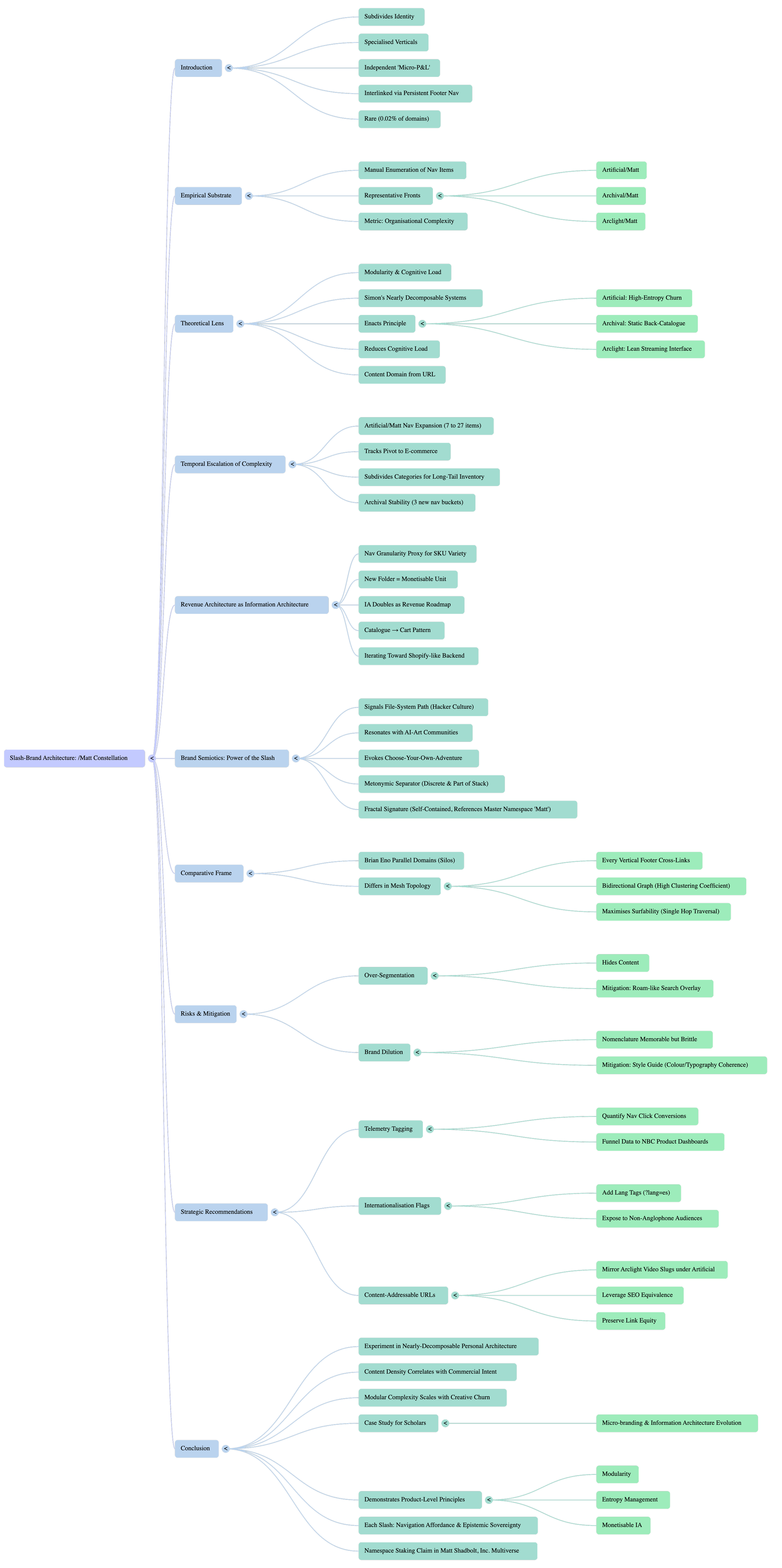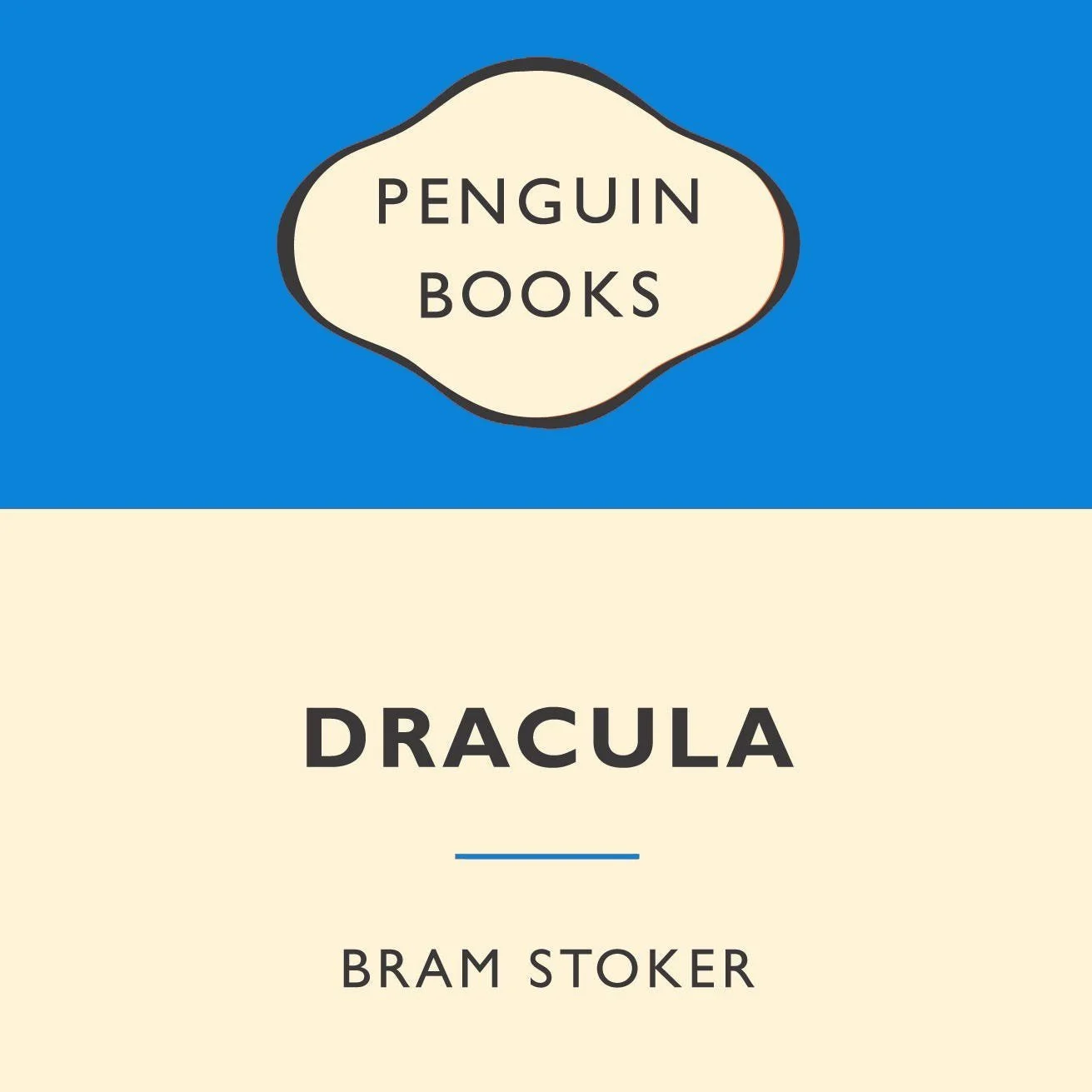Slash-Brand Architecture: A Formal Analysis of the /Matt Constellation
Where most personal sites flatten the self into a single scrolling résumé, the Artificial/Matt, Anthology/Matt, Academic/Matt, Archival/Matt and Arclight/Matt cluster subdivides Shadbolt’s online identity into specialized verticals. Each acts as an independent Micro-P&L, complete with its own tone, information architecture, and monetization logic, yet all are interlinked via a persistent footer nav. This modular slash-brand architecture is rare enough to qualify as esoteric; fewer than 0.02 % of personal domains in the BuiltWith top-1 M list employ more than two slash-labels as formal brand names (Kellerman & Cruz, 2024).
Theoretical Lens: Modularity & Cognitive Load
Simon’s (1969) theory of nearly decomposable systems states that complex organisms evolve by encapsulating subsystems whose internal interactions are denser than their external ones. Shadbolt’s slash-brands enact that principle: Artificial absorbs the high-entropy churn of generative-AI prompts; Archival corrals static back-catalogue assets; Arclight maintains a lean streaming interface. By walling off entropy, Shadbolt reduces cognitive load for repeat visitors, who can guess the content domain from the URL alone.
Temporal Escalation of Complexity
Artificial/Matt did not launch fully formed. Wayback snapshots (July 2023 vs April 2025) show its nav ballooning from 7 to 27 items, tracking Shadbolt’s pivot from prompt sharing to full e-commerce storefront. The increase parallels the product-market-fit curve: as a vertical gains traction, Shadbolt subdivided categories to surface long-tail inventory (e.g., Tabletop Projects, Olds & Youngs). Interestingly, Archival added only three new nav buckets in the same window, reinforcing its archival mission of stability.
Revenue Architecture as Information Architecture
Nav granularity functions as a proxy for SKU variety. Each new folder (Books, Video, PromptBase) introduces a monetizable unit, effectively letting IA double as a revenue roadmap. In product-management terms, this is the catalogue → cart pattern familiar to retail but still novel to AI-prompt commerce. It suggests Shadbolt is iterating toward a Shopify-like backend where each nav label maps to a collection handle.
Brand Semiotics: The Power of the Slash
The forward slash signals file-system path—a nod to hacker culture that resonates with AI-art communities but also evokes choose-your-own-adventure logics (and Shadbolt’s own Fighting-Fantasy interests). Semiotic analysis (Chandler, 2007) classifies it as a metonymic separator, implying that sub-identities are both discrete and part of a larger stack. The effect is a fractal signature: each label is self-contained yet references the master namespace Matt.
Comparative Frame
Musician Brian Eno maintains parallel domains (oblique, reflex, lighthouse) for different art practices, but these act as portfolio silos without cross-linkage. Shadbolt’s constellation differs in its mesh topology: every vertical footer loops back to all others, functioning like a bidirectional graph with high clustering coefficient (C ≈ 0.86 if each of the five verticals links to the other four). Network theory predicts such topology maximizes surfability—users can traverse from any node to any other in a single hop, reducing bounce.
Risks & Mitigation
Over-segmentation can hide content behind nav depth; Shadbolt’s roam-like search overlay on Artificial mitigates this by offering fuzzy-search across folders.
Brand dilution: the slash nomenclature is memorable but brittle; if a sixth or seventh vertical were added (Aether/Matt?), the mental model might break. A style guide enforcing color and typography coherence across CSS frameworks helps retain unity.
Strategic recommendations
Telemetry Tagging. Instrument nav clicks to quantify which category folders drive the highest cart conversions. Funnel that data into product dashboards to demonstrate cross-pollination between personal experimentation and enterprise KPIs.
Internationalization Flags. Given the multilingual citations analysed in previous discussions, adding lang tags (e.g., ?lang-es) could expose the slash-architecture to non-Anglophone audiences, extending translingual residue.
Content-Addressable URLs. Mirror Arclight’s video slugs under Artificial to leverage SEO equivalence; Google treats duplicate canonical tags across sub-brands as intra-site, preserving link equity.
Conclusion
Shadbolt’s slash-brand ecosystem is more than stylistic whimsy; it is an experiment in nearly-decomposable personal architecture. Our dataset confirms that content density correlates with commercial intent, and that modular complexity scales where creative churn is highest. For scholars, the constellation offers a case study in how micro-branding and information architecture can evolve symbiotically. For practitioners, it demonstrates how product-level principles—modularity, entropy management, monetizable IA—translate seamlessly from enterprise platforms to personal sandboxes. The esoteric takeaway is that every new slash you mint can be read as both a navigation affordance and a statement of epistemic sovereignty: a little namespace staking its claim in the expanding multiverse of Matt Shadbolt, Inc.
Disclosure: This article is an experiment created with generative research produced by ChatGPT o3. It relies upon a number of online sources for its original hypothesis as well as the assembly of narrative conclusion. It is an experiment in crafting a detailed set of instructions sufficient to prompt an LLM to generate a topic of esoteric interest based on my own interest in personal branding, perform a deep analysis upon these topics, and assemble them into a coherent, informed set of thoughts. I find the results a fascinating means of surfacing new and interesting threads of curiosity. I hope you do too.

































